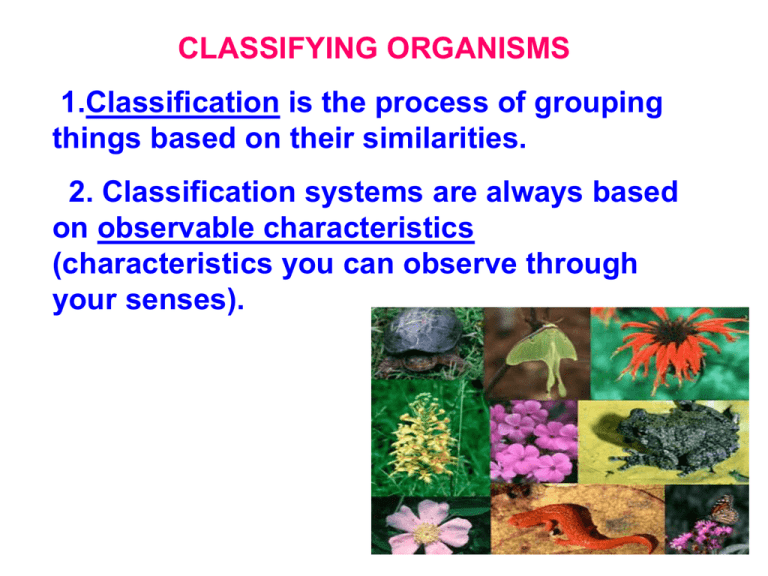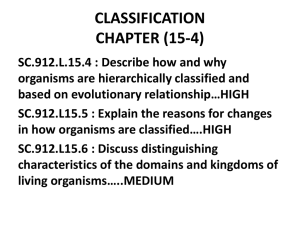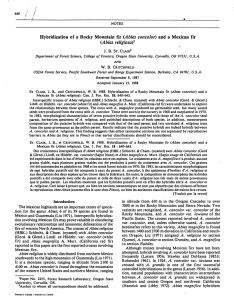Species
advertisement

CLASSIFYING ORGANISMS 1.Classification is the process of grouping things based on their similarities. 2. Classification systems are always based on observable characteristics (characteristics you can observe through your senses). • Biologists use classification to organize living things into groups so that the organisms are easier to study. 3.Taxonomy is the scientific study of how living things are classified. 4.A taxonomist is a scientist who classifies living things. Why do scientists classify? Classification systems organize living things in a logical, and meaningful way. This makes the study of living things easier. • Biologists have identified more than 2.5 million different types of living things to date. •Some estimate that there may be at least another 7 million different kinds of organisms living in tropical rain forests and deep in the oceans that have not yet been discovered. 5.To bring order to this great diversity of living things, we call BIODIVERSITY, biologists have developed systems of classification. Early Classification Systems 1. Grouped organisms as to whether they were beneficial or harmful 2. Recognized 5 animal groups: a. domestic b. wild c. creeping d. flying e. sea animals 6. First scientist to use a classification system was the Greek scholar, Aristotle. Aristotle: • 4 th century • Greek philosopher • Divided organisms into 2 groups –plants and animals • Divided animals into how they moved (behavior) a. walk, crawl, or run b. fly c. swim 7. Carolus Linnaeus- 1750s • Classified organisms based on similarities in form and structure. • Examined the organism’s internal anatomy as well as its outward structure. Puma, Cougar, or Mountain Lion? 8.Carolus Linnaeus developed a system for naming organisms called binomial nomenclature. In this system, each organism is given a two part name, called the scientific name. Ex. Felis concolor Genus species (general) (specific) Binomial nomenclature Name consisting of two terms A system of terms “ a system of names consisting of two terms” A two-name naming system Genus-species 9.The scientific name of an organism includes the genus and species. 10.The scientific name is written in Latin, because it was the language used by scientists when the naming system was invented. The language is also no longer used so it will not change and the names will also never change. • Genus is the first part of the scientific name. It is a classification grouping that contains similar and closely related organisms. • Example: Felis (genus) includes pumas, ocelots, and housecats. They all share the following characteristics: sharp, retractable claws and hunting behaviors Genus Felis • sharp, retractable claws • behaviors such as hunting other animals • Species is the second part of the scientific name. • A species is a group of similar organisms that can mate and produce fertile offspring. • A species name often describes a distinctive feature of an organism, like its color or where it lives. • Example: Felis concolor concolor means “the same color” in Latin; like a puma which is all one color; Example: Felis pardalis paradalis means “spotted like a panther” in Latin; like an ocelot which has a spotted coat; concolor = same color coat Felis concolor Species - ? paradalis = spotted coat Felis paradalis domesticus = house cat Felis domesticus • Scientific name is written in italics or each part must be underlined. Example: Felis concolor OR Felis concolor • Genus is written with a capital letter • Species is written with a lowercase letter. • The genus is written first and the species is written after it; • Examples Felis domesticus = house cat Pinus taeda = loblolly pine Musca domestica = housefly Ursus horribilis = grizzly bear LEVELS OF CLASSIFICATION • Linnaeus’ classification system uses a series of seven levels to classify organisms. • The more classification levels that two organisms share, the more characteristics they have in common. • The kingdom is the broadest classification level; species is the most specific. The Seven Levels of Classification according to Linnaeus 1. Kingdom Kings 2. Phylum Play 3. Class Cards 4. Order On 5. Family Fat 6. Genus Green 7. Species Stools broadest most specific Domains: 1. Archaea 2. Eubacteria (Bacteria) 3. Eukaryota (Eukarya) The Modern Levels of Classification 1. Domain Do 2. Kingdom Kings 3. Phylum Play 4. Class Cards 5. Order On 6. Family Fat 7. Genus Green 8. Species Stools broadest most specific Domain Domain Eukaryota (Eukarya) great horned owl THIS CATEGORY… IS MUCH LIKE THIS CATEGORY. Kingdom Planet Phylum Hemisphere Class Continent Order Country Family State Genus City Species Street Address Academy Road Caldwell What is the largest and most general level of classification? 1. Species 2. Phylum 3. Kingdom What is the two- part naming system devised by Carolus Linnaeus in the 18th century ? 1. Classification 2. Binomial nomenclature 3. Dichotomous system The science of grouping living things based on similarities is called _____. 1. classification 2. taxonomy 3. nomenclature In the scientific name Felis concolor, “ concolor” refers to 1. genus 2. family 3. species Which of the following is the correct form for writing the scientific name of an organism? 1. Felis Concolor 2. felis concolor 3. Felis concolor 4. Felis concolor Prokaryotic cell – does not have a nucleus Eukaryotic cell- has a nucleus Heterotrophic – does not make its own food Autotrophic – makes its own food Unicellular – made up of one cell Multicellular – made up of many cells The Six Kingdoms of Living Things Archaebacteria Eubacteria Protists Fungi Plants Animals 1. Archaebacteria –”ancient bacteria” live in extreme conditions like hot springs, your intestines, in molten rock on the ocean floor; “the extremophiles” prokaryotic; unicellular; autotrophic/heterotrophic 2. Eubacteria – live in non-extreme conditions like your throat, in yogurt and cheeses; some are harmful, but most are helpful; prokaryotic; unicellular; autotrophic/heterotrophic; Protists – the “junk drawer” kingdom; eukaryotic; unicellular/multicellular; autotrophic/ heterotrophic









